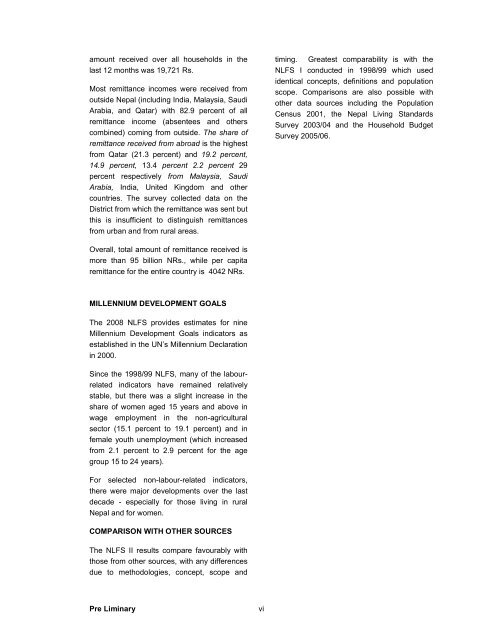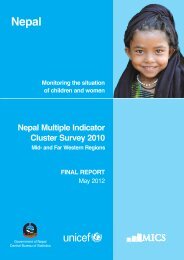Executive Summary of Nepal Labor Force Survey – 2008 (II)
Executive Summary of Nepal Labor Force Survey – 2008 (II)
Executive Summary of Nepal Labor Force Survey – 2008 (II)
Create successful ePaper yourself
Turn your PDF publications into a flip-book with our unique Google optimized e-Paper software.
amount received over all households in the<br />
last 12 months was 19,721 Rs.<br />
Most remittance incomes were received from<br />
outside <strong>Nepal</strong> (including India, Malaysia, Saudi<br />
Arabia, and Qatar) with 82.9 percent <strong>of</strong> all<br />
remittance income (absentees and others<br />
combined) coming from outside. The share <strong>of</strong><br />
remittance received from abroad is the highest<br />
from Qatar (21.3 percent) and 19.2 percent,<br />
14.9 percent, 13.4 percent 2.2 percent 29<br />
percent respectively from Malaysia, Saudi<br />
Arabia, India, United Kingdom and other<br />
countries. The survey collected data on the<br />
District from which the remittance was sent but<br />
this is insufficient to distinguish remittances<br />
from urban and from rural areas.<br />
timing. Greatest comparability is with the<br />
NLFS I conducted in 1998/99 which used<br />
identical concepts, definitions and population<br />
scope. Comparisons are also possible with<br />
other data sources including the Population<br />
Census 2001, the <strong>Nepal</strong> Living Standards<br />
<strong>Survey</strong> 2003/04 and the Household Budget<br />
<strong>Survey</strong> 2005/06.<br />
Overall, total amount <strong>of</strong> remittance received is<br />
more than 95 billion NRs., while per capita<br />
remittance for the entire country is 4042 NRs.<br />
MILLENNIUM DEVELOPMENT GOALS<br />
The <strong>2008</strong> NLFS provides estimates for nine<br />
Millennium Development Goals indicators as<br />
established in the UN’s Millennium Declaration<br />
in 2000.<br />
Since the 1998/99 NLFS, many <strong>of</strong> the labourrelated<br />
indicators have remained relatively<br />
stable, but there was a slight increase in the<br />
share <strong>of</strong> women aged 15 years and above in<br />
wage employment in the non-agricultural<br />
sector (15.1 percent to 19.1 percent) and in<br />
female youth unemployment (which increased<br />
from 2.1 percent to 2.9 percent for the age<br />
group 15 to 24 years).<br />
For selected non-labour-related indicators,<br />
there were major developments over the last<br />
decade - especially for those living in rural<br />
<strong>Nepal</strong> and for women.<br />
COMPARISON WITH OTHER SOURCES<br />
The NLFS <strong>II</strong> results compare favourably with<br />
those from other sources, with any differences<br />
due to methodologies, concept, scope and<br />
Pre Liminary<br />
vi
















